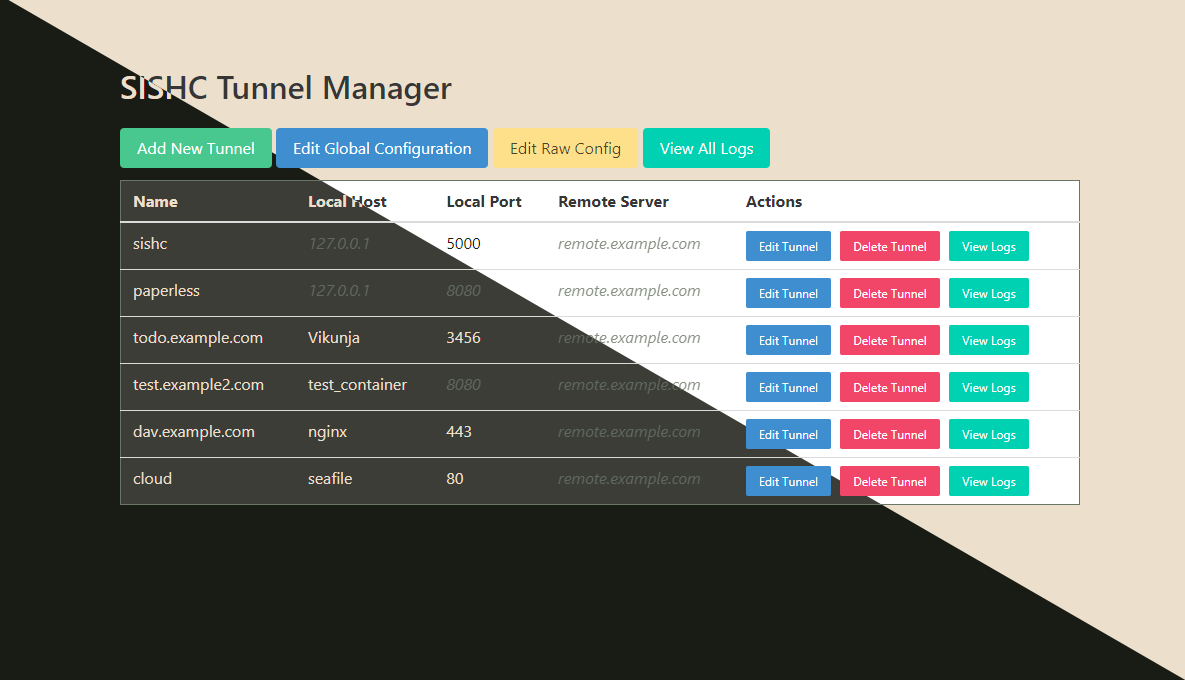SISHC Tunnel Manager is a lightweight, web app and bash script for managing sish tunnels.
The goal of this app is to quickly expose any local http/https/tcp server to a domain on a remote VPS, with built-in certificates and http to https handling.
The app enables you to add, edit, delete, and monitor SSH tunnels conveniently through a user-friendly interface, or by editing the config-file directly.
The project is built using Flask, Bulma, and Codemirror.
- Add New Tunnels: Create SSH tunnels with configurable local and remote settings.
- Edit Configurations: Update global and individual tunnel configurations via a streamlined interface.
- Manage Tunnels: Edit raw configurations directly or delete tunnels when no longer needed.
- View Logs: Access logs for individual tunnels or view aggregated logs.
- CLI update supported: Tunnels with be updated when a change is detected in the config-file.
Ensure that PUID and PGID is set as the same user that owns the config-dir and the private key(s) used.
After starting the container, access the web ui at port 5000, eg. http://127.0.0.1:5000
services:
sishc:
image: ghcr.io/lanjelin/sishc:latest
container_name: sishc
volumes:
- ./config:/config
- ~/.ssh:/config/.ssh:ro
environment:
- TZ=Europe/Oslo
- PUID=1000 # defaults to 1000
- PGID=1000 # defaults to 1000
# - USE_COLOR=false # toggle color in logs
# - SISHC_OUTPUT_LOG="/config/sishc.log" # change log path
ports:
- 5000:5000
restart: on-failure:10docker run --name sishc --rm -d -v ./config:/config -v ~/.ssh:/config/.ssh:ro -e TZ=Europe/Oslo -e PUID=${UID} -e PGID=${GID} -p 5000:5000 ghcr.io/lanjelin/sishc:latestThe configuration file at ~/.config/sishc/config.yaml should have the following structure:
# Global Configuration
ssh_key: "~/.ssh/id_rsa"
local_protocol: "http"
local_host: "localhost"
local_port: 8080
remote_port: 2222
remote_server: "example.com"
# Tunnel Specific Configurations
tunnels:
- name: "first_tunnel"
local_protocol: "http"
local_host: "localhost"
local_port: 8080
remote_port: 2222
remote_server: "example.com"
- name: "second_tunnel"
local_protocol: "https"
local_port: 4433
disabled: True
- name: "2512" # Expose ssh port to example.com:2512
local_host: 192.168.1.101
local_port: 22
local_protocol: tcpssh_key: Path to your SSH private key.local_protocol: Protocol to use for the local service (http,httpsortcp).local_host: Hostname or IP address of the local service.local_port: Port number of the local service.remote_port: Port number on the remote server.remote_server: Hostname or IP address of the remote server.disabled: Quckly disable a tunnel without deleting it, by setting this to true.tunnels: A list of tunnel configurations, each with a uniquename.name: The desired subdomain, or remote port when forwarding tcp.
I've attached an example as how I run sish in docker-compose-sish-example.yaml, for full instructions, see the docs.
Before using sishc.sh, ensure you have the following installed:
Requirements for web.py is listed in requiments.txt, if you want to use the web frontend.
-
Clone the repository:
git clone https://github.com/Lanjelin/sishc.git cd sishc -
Make the script executable:
chmod +x sishc.sh
-
(Optional) Move the script to a directory in your PATH for easier access:
mv sishc.sh /usr/local/bin/sishc
Run the script to start managing your sish tunnels:
./sishc.shYou can also run it in the background or as a service to keep your tunnels active.
Logs are written to ~/.local/share/sishc/sishc.log by default. You can change the log file location by setting the SISHC_OUTPUT_LOG environment variable.
By default, the script uses colored output. You can disable this by running the script with the --no-color flag:
./sishc.sh --no-colorContributions are welcome! Please feel free to submit a pull request or open an issue for any bugs or feature requests.
This project is licensed under the GPL-3.0 License. See the LICENSE file for details.
This README was mostly written by GPT-4o

